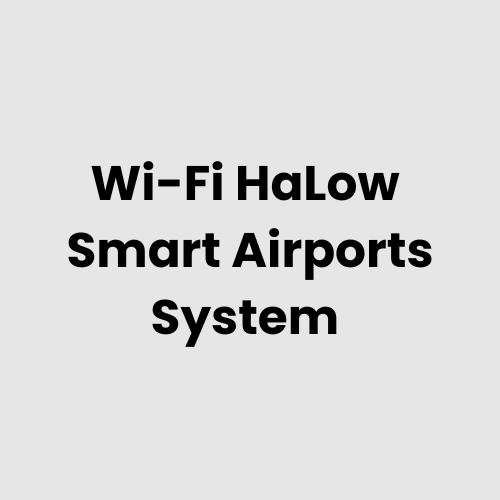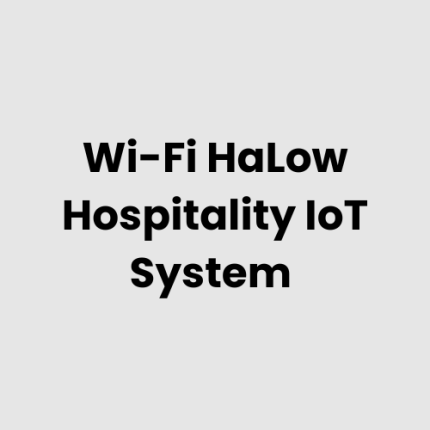Description
Wi-Fi HaLow Enabled Smart Airports System: Technical Architecture
The Wi-Fi HaLow Enabled Smart Airports System integrates advanced Internet of Things (IoT) technology to enhance efficiency, safety, and passenger experience in airports. By leveraging Wi-Fi HaLow (IEEE 802.11ah), a low-power, long-range wireless technology, the system connects a range of smart devices across the airport environment. This system offers real-time data monitoring, streamlined operations, and improved security, transforming the airport into a smart, automated environment.
The technical architecture of this system is composed of several key components working together:
- Connectivity Layer: At the heart of the architecture is Wi-Fi HaLow, offering long-range, low-power connectivity. This layer ensures seamless communication between IoT devices, sensors, cameras, and control systems across the airport premises, enabling operational efficiency and high scalability.
- Sensor and Device Layer: A network of IoT sensors and smart devices are strategically deployed across the airport for various functions such as security, passenger tracking, asset management, and environmental monitoring. These devices include RFID readers, security cameras, motion sensors, environmental sensors, and more.
- Edge Computing Layer: To reduce latency, edge computing devices are deployed to process data locally at the airport. This allows for real-time analysis and rapid decision-making, without overloading the central system with unnecessary data.
- Cloud Layer: Data collected from sensors and devices is sent to the cloud for storage, aggregation, and advanced analytics. The cloud platform enables scalable data processing, real-time monitoring, predictive analytics, and reporting for airport management.
- Security and Privacy Layer: With sensitive passenger and airport data being processed, this layer ensures secure communications and data storage. This includes encryption protocols, identity management, access controls, and compliance with data protection standards.
Hardware Components of the Wi-Fi HaLow Enabled Smart Airports System
The hardware of the Wi-Fi HaLow Enabled Smart Airports System is designed to meet the diverse needs of airport operations, providing real-time monitoring, automation, and data processing capabilities. Key hardware components include:
- Wi-Fi HaLow Routers and Gateways: These devices provide long-range and low-power wireless connectivity for all IoT devices and sensors across the airport. Wi-Fi HaLow gateways enable seamless communication across multiple zones, ensuring reliable network coverage for both terminal and airside areas.
- IoT Sensors:
- Passenger Tracking Devices: Wearable devices, such as RFID tags or mobile apps, allow for real-time tracking of passengers as they move through the airport, helping with crowd management and reducing wait times.
- Security Cameras and Motion Sensors: These devices continuously monitor the airport for security, enabling real-time surveillance and anomaly detection.
- Environmental Sensors: Temperature, humidity, and air quality sensors are deployed throughout the airport to ensure optimal comfort and safety for passengers and staff.
- Asset Management Sensors: RFID and GPS sensors are used to track luggage, equipment, and other airport assets to reduce losses and improve operational efficiency.
- Edge Computing Devices: These devices process data at the edge, on-site at the airport. By performing initial analysis locally, these devices minimize the time it takes to make decisions, such as triggering alerts or activating systems like lighting or air conditioning.
- Local Servers: These are used for backup data storage and local processing in case of network failure, ensuring uninterrupted service for critical operations. Local servers also reduce the load on the cloud and handle specific tasks like real-time security monitoring.
- Control Consoles and Dashboards: These provide airport managers and operators with intuitive interfaces to monitor operations, visualize data, and receive alerts. They offer real-time monitoring of airport functions such as passenger flow, security status, and environmental conditions.
- Actuators and Control Systems: These include automated systems for controlling lighting, HVAC (heating, ventilation, and air conditioning), escalators, and other airport infrastructure that can be triggered by sensor data.
Physical Placement Considerations of the Hardware
The effectiveness of the Wi-Fi HaLow Enabled Smart Airports System depends on proper placement of hardware throughout the airport. Key considerations include:
- Wi-Fi HaLow Routers and Gateways: These should be strategically located to provide full coverage across the airport, including both indoor terminals and outdoor airside areas. Multiple routers may be needed in large terminals or high-density areas to ensure continuous connectivity.
- IoT Sensors:
- Passenger Tracking Devices should be distributed at key points such as check-in counters, security checkpoints, boarding gates, and baggage claim areas.
- Security Cameras and Motion Sensors should be placed at entrances, exits, corridors, and other critical areas to ensure continuous surveillance and detect any unauthorized access.
- Environmental Sensors should be distributed across terminals, waiting areas, and other high-traffic zones to monitor air quality and temperature.
- Asset Management Sensors should be attached to luggage carts, equipment, and other moveable assets in the airport to ensure accurate tracking.
- Edge Computing Devices: These should be placed near critical data collection points to minimize the data transfer delay. For instance, placing them in terminals or airside areas where immediate responses are needed (e.g., adjusting HVAC settings based on crowd density) will optimize the system’s performance.
- Local Servers: In the event of a failure in cloud connectivity or where real-time data processing is required, local servers should be placed in secure, climate-controlled rooms within the airport’s control center or data center.
- Control Consoles and Dashboards: These consoles should be placed in central command rooms, where airport management can have a comprehensive overview of airport operations and respond to alerts promptly.
Hardware Architecture of the Wi-Fi HaLow Enabled Smart Airports System
The architecture follows a distributed, multi-layered approach to optimize data flow, security, and control:
- Connectivity Backbone: The Wi-Fi HaLow routers and gateways form the backbone of the system, enabling devices to communicate with minimal power consumption and ensuring that airport systems operate seamlessly over long distances.
- Sensor and Device Layer: Various sensors, including passenger tracking, security cameras, and environmental monitoring devices, provide critical data points for managing airport operations. These devices form the sensory interface of the smart airport system.
- Edge Computing Layer: Edge devices process sensor data locally, which allows for real-time analysis and response. For example, this layer can manage crowd control by adjusting lighting and HVAC settings based on passenger density.
- Data Management Layer: The cloud or local servers aggregate and store data, which is then analyzed for trends, predictive analytics, and reporting. This layer allows for in-depth insights into airport operations and facilitates decision-making processes.
- Actuation Layer: Based on the analyzed data, actuators trigger automatic actions, such as adjusting environmental conditions or managing airport assets.
Deployment Considerations of the Wi-Fi HaLow Enabled Smart Airports System
Deployment of the Wi-Fi HaLow Enabled Smart Airports System requires careful planning to ensure robust performance and scalability:
- Network Infrastructure: Adequate planning of the Wi-Fi HaLow network is essential to ensure full coverage across both terminal and airside areas. Multiple routers and access points may be required, depending on the airport’s size and layout.
- Sensor Calibration and Placement: Sensors must be carefully calibrated for their intended use and properly placed to optimize data accuracy and coverage. Strategic positioning ensures maximum data capture for accurate monitoring.
- Power Supply: Many of the IoT devices in airports require stable power sources. For devices in remote locations, consideration should be given to using renewable energy sources like solar panels or backup power systems.
- Security and Privacy: Given the high volume of passenger data processed, security measures such as encryption, multi-factor authentication, and network segmentation must be implemented to ensure data protection and compliance with privacy regulations.
- Integration with Existing Systems: The smart airport system should be able to integrate seamlessly with legacy systems (e.g., baggage handling, check-in kiosks) for enhanced operational efficiency and data sharing.
List of Relevant Industry Standards and Regulations
- ISO 27001: Information Security Management Systems
- ISO 9001: Quality Management Systems
- FCC (Federal Communications Commission) Regulations
- GDPR (General Data Protection Regulation)
- NIST Cybersecurity Framework
- PCI DSS (Payment Card Industry Data Security Standard)
- ACI (Airports Council International) Standards
- IATA (International Air Transport Association) Standards
- IEEE 802.11ah (Wi-Fi HaLow Standard)
- S. TSA (Transportation Security Administration) Regulations
Local Server Version: Running with a Local Server
The Wi-Fi HaLow Enabled Smart Airports System can operate with a local server version, offering several key advantages:
- On-Site Data Processing: Local servers handle the processing of sensor data on-site, minimizing the need for constant cloud communication and reducing data transfer delays.
- Reliability in Remote Locations: In airports with limited cloud connectivity, local servers ensure that critical functions, such as security monitoring and operational alerts, continue to operate even during network interruptions.
- Security and Control: By hosting the system locally, airport authorities maintain full control over sensitive data, ensuring that only authorized personnel can access operational data.
Cloud Integration and Data Management
The cloud integration of the Wi-Fi HaLow Enabled Smart Airports System offers scalability, remote monitoring, and advanced analytics:
- Centralized Data Storage: Data from various IoT devices is sent to the cloud for storage and aggregation. This allows for seamless access to data and analytics across different terminals and airport areas.
- Predictive Analytics: With cloud-based analytics, airport managers can forecast passenger flow, predict maintenance needs, and optimize resource allocation.
- Scalability: The cloud platform enables the system to scale with ease, accommodating new sensors, devices, and additional terminals without requiring extensive on-site infrastructure upgrades.
- Remote Access: Cloud connectivity allows airport managers to monitor operations from anywhere, providing flexibility and ensuring that they can respond quickly to emerging situations.
GAO Case Studies of Smart Airports
USA Case Studies
- Atlanta, Georgia: Smart systems at Atlanta’s airport implemented RFID technology to streamline baggage handling, significantly reducing lost luggage incidents and improving overall passenger satisfaction. GAO Tek offers advanced RFID solutions to enhance airport operations. Discover RFID for baggage tracking.
- Dallas, Texas: IoT-enabled environmental sensors at Dallas-Fort Worth optimized HVAC systems, ensuring energy efficiency while enhancing passenger comfort. GAO Tek provides tailored IoT tools to support sustainable airport management. Explore IoT for energy efficiency.
- Denver, Colorado: BLE beacons in Denver’s airport guided passengers seamlessly to gates and amenities, enhancing navigation for travelers. GAO Tek’s innovative BLE technologies revolutionize wayfinding solutions. Learn about BLE beacons.
- Chicago, Illinois: Advanced facial recognition systems at Chicago’s airport accelerated boarding processes and improved security measures. GAO Tek supplies cutting-edge AI solutions for smart airport operations. Discover AI for security.
- Miami, Florida: Real-time tracking of ground support equipment at Miami’s airport streamlined logistics and enhanced operational efficiency. GAO Tek delivers robust asset tracking technologies. Explore asset tracking solutions.
- Seattle, Washington: IoT-based predictive maintenance in Seattle’s airport minimized downtime of escalators and moving walkways, ensuring smoother passenger flow. GAO Tek provides IoT systems designed for proactive maintenance. Learn about IoT for predictive maintenance.
- San Francisco, California: Smart lighting systems in San Francisco’s airport adjusted automatically based on passenger density, cutting energy costs. GAO Tek’s IoT-enabled lighting solutions support energy-efficient infrastructure. Discover smart lighting for airports.
- Orlando, Florida: Orlando’s airport introduced smart kiosks for contactless check-ins, reducing congestion and improving passenger experiences. GAO Tek empowers airports with user-friendly self-service technologies. Learn about smart kiosks.
- Las Vegas, Nevada: Smart parking systems at Las Vegas airport helped drivers locate available spaces in real time, enhancing convenience and efficiency. GAO Tek offers cutting-edge parking management technologies. Explore smart parking systems.
- Phoenix, Arizona: Phoenix’s airport employed real-time monitoring for runway conditions to enhance safety, especially during extreme weather. GAO Tek supports airport safety with innovative IoT monitoring tools. Learn about IoT for runway safety.
- Boston, Massachusetts: AI-powered analytics at Boston’s airport optimized flight scheduling and gate assignments, ensuring smoother operations. GAO Tek delivers powerful data-driven technologies to streamline airport processes. Explore AI analytics for airports.
- Houston, Texas: Houston’s airport utilized RFID and GPS technologies to monitor cargo movements in real time, improving supply chain efficiency. GAO Tek specializes in comprehensive cargo tracking systems. Discover RFID for cargo management.
- New York City, New York: Automated air quality monitoring systems in New York’s airport ensured a healthier environment for passengers and staff. GAO Tek’s IoT solutions support compliance with modern environmental standards. Explore air quality monitoring.
- Los Angeles, California: Wearable technologies for staff in Los Angeles’s airport enhanced communication and coordination, improving overall response times. GAO Tek delivers advanced workforce optimization solutions. Discover wearable tech for airports.
- Detroit, Michigan: BLE-based smart boarding systems in Detroit’s airport improved passenger flow by automating gate access and reducing wait times. GAO Tek enhances boarding efficiency with its innovative BLE technologies. Learn about BLE for smart boarding.
Canada Case Studies
- Toronto, Ontario: Smart luggage tracking and automated customs clearance at Toronto’s airport significantly improved passenger throughput. GAO Tek offers scalable RFID and IoT systems for Canadian airports. Explore IoT for luggage tracking.
- Vancouver, British Columbia: Environmental monitoring systems at Vancouver’s airport ensured sustainable operations by tracking key metrics in real time. GAO Tek supports green airport initiatives with state-of-the-art IoT solutions. Discover IoT for environmental sustainability.
Navigation menu for Wi-Fi HaLow
Wi-Fi HaLow HomePage
- Wi-Fi HaLow Gateways/Routers
- Wi-Fi HaLow End Devices
- Wi-Fi Halow – Cloud, Server, PC & Mobile Systems
- Wi-Fi HaLow Accessories
Navigation Menu for IoT
IOT Home Page
- LORAWAN
- Wi-Fi HaLow
- Z-WAVE
- BLE & RFID
- NB-IOT
- CELLULAR IOT
- GPS IOT
- IOT SENSORS
- EDGE COMPUTING
- IOT SYSTEMS
Our products are in stock and can be shipped anywhere in the continental U.S. or Canada from our local warehouse. For any further information, please fill out this form or email us.
We are looking for partners. For more information on partnering with GAO, please visit Partner with GAO Tek Inc. It lists various ways to partner with GAO, such as OEM Partnerships, Technology Integration, Distribution and Reselling Opportunities, Presenting at the Leading Event TekSummit, Joint R&D Projects, Training and Consulting Services, Industry-Specific Collaborations, Research and Academic Partnerships.



